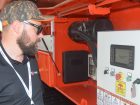
Features
Aggregates
Technology
Telematics on the rise
Contractors aggressively pursuing more machine data
March 27, 2017 By Andrew Snook
 Contractors are pursuing the collection of data from their fleets more aggressively than ever before.
Contractors are pursuing the collection of data from their fleets more aggressively than ever before. March 27, 2017 – A trend has been taking hold in the construction sector, and that is increased interest in the collection of data from contractors’ fleets to find ways to enhance and optimize operations. Although telematics itself is not brand new, contractors are pursuing the collection of data from their fleets more aggressively than ever before.
Paul Kearnan, national telematics specialist for Strongco, says that telematics can be used to reduce a wide array of costs for an operation.
“Reports can show how hard a machine is really working,” he says. “From buying machines, to how many machines are needed, fuel, safety, how things are running, it really encompasses everything. More and more customers are becoming aware. It’s there, so why not use it?”
Of course, collecting data is the easy part. Afterwards you need to know how to capitalize on the information you’ve acquired to make it truly valuable to your company.
Jena Holtberg-Benge, director of John Deere WorkSight, says her company has seen a change in fleet management where contractors are adapting more to the use of telematics in their operations, but they have questions like, “How do I use the data and associate it with the equipment? How do I make sense of the data to provide me insights that help me manage my fleet better?”
When it comes to aggregate operations, one of the areas Holtberg-Benge says John Deere differentiated itself from competitors for years was the integration of the Loadrite payload scale data with telematics.
“That was a really big win for a lot of our customers in quarry and aggregate,” Holtberg-Benge says. “They understand how their machines are performing, how many loads they get a day… it’s a big deal in that space.”
Maintenance management
Strongco’s Kearnan says that a good telematics system is essential for having a good fleet maintenance program in place.
“It’s complete machine care,” he says. “It shows the fuel you’re using; how many hours service worked – even the attachments; you can monitor idle time to prevent idling away warranty hours and service time. Otherwise you’re just wasting away money… you can even use it to your advantage for resale value or for buying used equipment to see what servicing has been done to a machine.”
John Deere has recently been migrating from its old platform to its new HTML5 platform, the JDLink dashboard. The company’s new system includes a maintenance management app called My Maintenance.
“It’s been well received by customers,” says Holtberg-Benge. “We’ve seen over 5,000 preventative maintenance plans loaded by customers – customer plans and factory plans.”
This has allowed contractors to manage their fleets more effectively, and also given them the option to collaborate with their dealers to have them manage the equipment servicing.
Remote site management
Another advantage is being able to manage operations remotely.
“It’s an advantage for a fairly big contractor that’s not on site, being able to see who’s working,” says Alan Witherow, product manager for Terex Finlay.
Telematics systems, like Terex Finlay’s T-Link system, allow a contractor to create of a variety of automated reports about their crushing fleets.
For example, a contractor can use belt scales to see total tonnage over a week of operation. Terex Finlay’s T-Link system comes standard on all of its crushers. The system allows contractors to track a machine’s history to see where it has been over a specified period of time.
“It gives an actual GPS location of a unit,” Witherow says. “You can see where they’ve been crushing.”
The T-Link system also allows for tracking the hours a machine is in operation over a one-day, seven-day or 30-day period or the lifetime of a machine; track fuel consumption; engine usage and more.
“This is the kind of information you’d get if you were standing in front of the machine,” Witherow says.
Another advantage of some telematics systems is for parts and service support.
Witherow says that the technical support team at Terex Finlay’s factory in Ireland can view the history of a machine in another part of the world and check its history to help diagnose issues a contractor is having with their unit.
The history of a machine can also be used for proactive maintenance for replacing wear components and hydraulic oil, for example, helping reduce downtime.
“Some dealers do proactive monitoring of their machines and have service contracts to back them up,” Witherow says.
Contractors can also take advantage of some telematics systems, like the T-Link system, to set up geo fencing around a unit. This allows for an alarm to be set that would be triggered if a machine was moved from a specified area.
Winning bids
Willy Schlacks, president at EquipmentShare, says the aggregation of data will allow contractors for more insight when bidding on jobs to more accurately figure out costs.
“You can get an idea of how many man-hours of operation are needed to do a job,” Strongco’s Kearnan adds.
Schlacks says that in future telematics everything will already be connected and connect to a user’s web of current connectivity.
“That’s probably a good four or five years out, but those steps are happening now,” he says. “And the guys who adopt this and continue to grow with these improvements will benefit greatly… and be far more competitive and more profitable.”
That said, not all telematics systems are created equal. Schlacks says that contractors should do exhaustive research up front to make sure the system they invest in delivers what they need.
Print this page



